Inner German relations
This article needs additional citations for verification. (July 2022) |
 | |
West Germany |
East Germany |
|---|---|
Inner German relations (
History
Postwar period
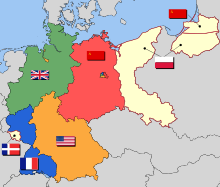
After the unconditional surrender of the
Important milestones of the gradual demarcation were the US-led Marshall Plan in 1947 as well as the Western currency reform and the Berlin blockade in 1948. The integration of the western occupation zones into the community of the Western powers and that of the eastern part into the system of the USSR finally accompanied the founding of the Federal Republic of Germany and that of the GDR in 1949.
Intensification of the Cold War
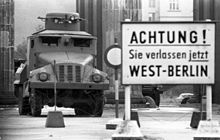
The outbreak of the
Economically, the young Federal Republic was bound to the Western powers on the basis of the 1957
While Chancellor
On August 13, 1961, the communist regime de facto separated Berlin into East and West Berlin by building the Berlin Wall. In this way, the GDR put a temporary end to the increasing exodus of its highly educated population and to any lingering hopes of reunification in the near future. The GDR was stabilized in this way. The people who remained in the GDR no longer had the option of going to the West via West Berlin and had to come to terms with the regime.
West German policy of détente
The Cuban Missile Crisis of 1962, when the world was on the brink of nuclear war, marked the turning point of the Cold War, towards a policy of cooperation and détente, which also affected inner German relations through a changed political climate.
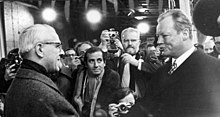
Nevertheless, the last time there was an all-German team was at the 1964 Summer Olympics in Tokyo. At the same time, the GDR began to release political prisoners from its prisons.[1][2]
The new Ostpolitik of the social-liberal government under Chancellor Willy Brandt played a decisive role in political rapprochement. Even in the period before the grand coalition that ended the Adenauer era in 1966, Brandt, together with his press spokesman Egon Bahr, had prepared these foreign policy guiding principles of the "policy of small steps," "change through rapprochement" and "human facilitation." Within just three years, after the symbolic prelude with the Erfurt summit in 1970, the Eastern treaties with Moscow, Warsaw and Prague, the four-power agreement on Berlin, the declaration of renunciation of force vis-à-vis the Eastern European states and the Basic Treaty with the GDR were concluded.[3] For the first time, these treaties recognized that the sovereignty of each of the two states was limited to its national territory. Moreover, the independence and autonomy of each of the two states in its internal and external affairs were respected. Strategies such as the Hallstein Doctrine, which the GDR had responded to with the Ulbricht Doctrine, were overcome with Article 4 of the Basic Treaty, in which both sides assumed "that neither state can represent the other internationally or act on its behalf." Nevertheless, the Federal Republic of Germany and the GDR did not recognize each other as independent states in the sense of international law. Therefore, no ambassadors were sent, but permanent representatives based with the respective governments in Bonn and East Berlin were exchanged, to whom the Vienna Convention on Diplomatic Relations applied accordingly. On March 14, 1974, the Protocol on the Establishment was signed in Bonn.[4][5] The Federal Chancellery, rather than the Foreign Office, was responsible for the Permanent Mission of the GDR in Bonn,[6] while the Ministry of Foreign Affairs of the GDR was responsible for matters concerning the Permanent Mission of the Federal Republic of Germany in East Berlin.[7]
On May 7, 1974, Willy Brandt resigned after the Guillaume affair.[8]
The policy of normalization nevertheless served to defuse the international East-West conflict and set the stage for the 1975 Conference on Security and Cooperation in Europe (CSCE) and the talks on troop limitations. However, the "regulated coexistence" achieved cemented the status quo to such an extent that after more than 20 years in both German states, few still believed in the feasibility of reunification.
In the GDR, people reacted to the new developments in détente with a new demarcation in order to find their own state identity. With its willingness to engage in dialogue, the state had gained international recognition. In 1973, the Federal Republic and the GDR became members of the UN. Increasing economic performance also raised the nation's self-confidence, which led the Volkskammer in 1974 to delete the terms German nation and reunification from the constitution of the German Democratic Republic. The fact that too much independence could also lead to conflict with the Soviet Union had already been felt in 1971 by Walter Ulbricht, who had been replaced in his position as first secretary of the SED by Erich Honecker because of his refusal to reform.
1970 to 1988
Meanwhile, the two oil crises in the 1970s had a devastating effect on the GDR's economic development and led to discontent among the population, but not to structural reforms. Emerging opposition groups were repressed by the state security's tightly meshed network of informers in order to maintain political stability in the country.
A disruption of Inner German relations followed the
In the meantime, Inner German relations were strained by a new wave of international rearmament, culminating in the
In 1986, Eisenhüttenstadt and Saarlouis established the first German-German town twinning.
Erich Honecker's visit to the Federal Republic of Germany in 1987, which had been planned for years, was seen by both states as an important step in the development of German-German relations. The GDR leadership saw the event as the culmination of (de facto) recognition.
1989/90
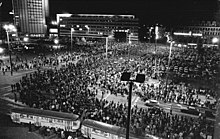
Gorbachev's reform policy of Perestroika and Glasnost, along with the noticeable defusing of the international East-West conflict through binding disarmament agreements between the USSR and the USA, ultimately led to the revolutions in 1989 in the individual states of the Eastern Bloc as well.
Under Gorbachev's Sinatra Doctrine, Moscow no longer stood in the way of gradual democratization. Thus, Hungary was able to open its border with Austria in August 1989. With the onset of mass exodus, opposition movements within the GDR also gained new momentum, resulting in nationwide Monday demonstrations. On November 9, 1989, Günter Schabowski, a member of the Politburo of the SED, declared at a press conference that East German citizens were free to travel, whereupon all inner-German border crossings were opened.[9] The fall of the Berlin Wall represented a high point in the course of the peaceful revolution.
The "window of history" that was now open for reunification moved all parties to act quickly: The SED offered the opposition roundtable talks, and Helmut Kohl single-handedly presented his ten-point program for overcoming the division of Germany. On May 18, 1990, the East German government under Lothar de Maizière, which had emerged from the People's Chamber elections on March 18, 1990, concluded the Treaty on the Creation of a Monetary, Economic and Social Union.[10]
Taking into account the agreements and decisions of the victorious powers from the wartime and postwar periods, the Two-plus-Four Treaty of September 12, 1990, made final arrangements with regard to Germany. Accordingly, the united Germany comprises the territories of the Federal Republic of Germany, the German Democratic Republic and the whole of Berlin. It does not make any territorial claims over and above these against other states.[11] Since then, the German question has been regarded as settled in political terms and under international law.
On August 23, 1990, the People's Chamber decided on the East German's accession to the Federal Republic of Germany in accordance with Article 23 of the Basic Law.
On the night of October 2 to 3, 1990, the German federal flag was hoisted at the Reichstag building in Berlin.
The Federal Ministry for Internal German Relations was dissolved on January 1, 1991.[14]
By organizational decree of the Federal Chancellor of October 27, 1998, a Federal Government Commissioner for the New States of Germany was appointed.
Even 30 years after the establishment of German unity, there are significant differences in the living conditions of the western and eastern states of Germany.[15]
Treaties between West Germany and East Germany
Germany policy since the Grand Coalition of 1966 consisted primarily of seeking negotiations and treaties with the GDR. Since 1969, numerous treaties, agreements and arrangements have been concluded by SPD-led federal governments.[16][17] Article 7 of the Basic Treaty provided for agreements in the fields of economics, science and technology, transportation, legal relations, postal and telecommunications services, health care, culture, sports, environmental protection and other areas.
These included:
- Postal Agreement between the Federal Republic of Germany and the GDR of September 30, 1971.
- Transit agreement of December 17, 1971
- Agreement between the Government of the German Democratic Republic and the Senate of West Berlin on Facilitating and Improving Travel and Visiting Traffic of December 20, 1971[18]
- Treaty between the Federal Republic of Germany and the German Democratic Republic on Transport Issues of May 26, 1972 (Local Border Traffic)
- Basic Treaty of December 21, 1972
- German-German Cultural Agreement of May 6, 1986[19]
- Treaty on Monetary, Economic and Social Union of May 18, 1990
- Unification Treatyof August 31, 1990
Trade relations

Interzone trade, which had already begun in 1946, was placed on a new footing after the currency reforms and the two state foundations on September 20, 1951, with the Agreement on Trade between the Currency Areas of the German Mark (
The exchange of goods was regulated on the basis of lists of goods. These required approval and were subject to quotas in terms of quantity and value (initially to a considerable extent).[27][28] Payment transactions were not carried out by direct payments between the companies involved, but were settled by clearing via various sub-accounts at the central banks of the Federal Republic and the GDR.[29] The unit of payment agreed upon was the so-called clearing unit (VE).[30]
The two economies, both poor in raw materials, exchanged mainly basic materials and production goods, with a share of over 50%. While the Federal Republic supplied the GDR mainly with
In the 1970s, the share of intra-German trade in total foreign trade turnover averaged 5.1% in the Federal Republic, but was almost twice as high in the GDR at 9.4%.[33] The benefits that the GDR derived from intra-German trade in the form of interest and customs duty savings and VAT reductions were estimated at around DM 750 million for the 1980s.[34]
The guarantee of DM 1 billion granted to the Foreign Trade Bank of the GDR by the Federal Government to a consortium of West German banks on June 29, 1983, was not only for economic reasons, but was also seen politically by the Federal Government "as an important contribution to improving relations with the GDR".[35][36]
Section 12 of the Treaty on Monetary, Economic and Social Union of May 18, 1990 adapted the Berlin Agreement of September 20, 1951 with regard to monetary and economic union. The clearing system regulated there was terminated and the closing balance of the swing was settled. Existing obligations were settled in German marks. The complete abolition of goods controls at the inner-German border was a consequence of the Unification Treaty.
Travel
The demarcation lines between the four occupation zones were established by the victorious powers on the basis of the zone protocols after the end of
The interzone passport, which had still been introduced by the Allies, was replaced in 1953 by the so-called personal certificate for travel from the GDR to West Germany.[37] To enter the GDR from West Germany, an official identity card and a residence permit issued by the council of the district of the place to be visited were required; when entering East Berlin, a special permit was required from 1960. For travel between West Germany and West Berlin, an identity card was sufficient.[38]
In June 1968, passport and visa requirements were introduced.[39][40]

On August 12, 1961, following a corresponding resolution of the People's Chamber the previous day, the
The decision went into effect on August 13, 1961, and led not only to the construction of the Berlin Wall, but also to a significant tightening of German-German travel regulations overall.
Existing permits for travel by GDR citizens to "capitalist foreign countries" were declared invalid and confiscated. Only in cases where there was "a justified state, social or cultural interest" could a renewed application be made to the Ministry of the Interior (Headquarters of the German People's Police).[42] Persons up to the age of 25 were prohibited from leaving the country. While around 2.5 million travel permits to the Federal Republic had been issued annually before the Wall was built, only 623 permits to travel to West Germany and 645 passes to enter West Berlin had been issued since then until 1965. Travel was to be prevented "where there is no absolute necessity or where there is reasonable suspicion that it is intended to be exploited to leave the German Democratic Republic illegally."

In 1964, travel conditions were eased for persons receiving old-age, accident, or disability pensions, and later for so-called travel cadres.[38]
By order of November 25, 1964,[43] a mandatory minimum exchange of foreign currencies had been introduced for private visitors from West Germany. The amount per day of duration was fixed from an equivalent of initially 5 to finally 25 GDR marks at the conversion ratios applicable in the GDR.[38]
The border could only be crossed with valid documents at the existing control crossing points. Violations were punishable by imprisonment under Section 8 of the 1954 Passport Act, and under Section 213 of the Criminal Code as of July 1, 1968, as unlawful border crossing.
From 1972, the Agreement on Facilitation and Improvement of Travel and Visits initially allowed persons permanently residing in West Berlin to enter East Berlin and the GDR for humanitarian, family, religious, cultural and tourist reasons.[44] The Transport Treaty of May 26, 1972, then regulated traffic into and through the respective territories on roads, railways, and waterways "in accordance with customary international practice on the basis of reciprocity and nondiscrimination."[44] On May 30, 1972, the Politburo of the SED presented "Principles for the Processing of Applications for Departures of Citizens of the GDR to Non-Socialist States [...] and Entries of Citizens of the FRG into the GDR," concretized by an order of the Minister of the Interior of October 17, 1972. Travel on the occasion of births, marriages, life-threatening illnesses, and deaths of grandparents, parents, children, and siblings could be approved thereafter once or several times up to a total duration of 30 days per year. Travel permits were virtually not granted to persons who could not state urgent family matters or who were of retirement age. It "can therefore be said that the period 1961-1975 was one of extensive travel prohibition throughout."[45]
In many cases, personal meetings took place at transit highway rest stops, even though travelers there had to reckon with surveillance by the Ministry for State Security. As a result of the travel facilitations for West Germans that came with the Transit agreement and the Basic Treaty (including residence in the entire GDR, free choice of border crossing, visits also to acquaintances and not only to relatives, trips several times a year, tourist trips, permission for car traffic, opening of new road crossings, traffic close to the border), travel with the GDR then "increased by leaps and bounds in the further course of the 1970s."“[46]
After government representative Günter Schabowski declared at a press conference on October 9, 1989, that it should be possible to apply for private travel abroad without having to meet certain requirements (reasons for travel and family relationships), the border crossings throughout Germany were literally overrun with people wanting to travel. Since then, de facto border controls no longer took place.[47]
The decree of 21 December 1989 abolished the visa requirement for citizens of the Federal Republic of Germany entering the GDR,[48] and the decree of 16 May 1990 also abolished the passport requirement.[49]
Since July 1, 1990, there have been no more controls on the movement of persons across the inner-German borders. Germans and foreigners who met the entry requirements were allowed to cross the inner-German borders at any point.[50][51]
Many East Germans had tried to leave for West Germany illegally. Some of the people were East German guards/soldiers.

Culture
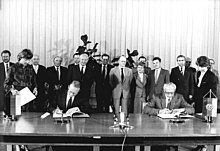
Article 7 of the Basic Treaty provided, among other things, for the conclusion of agreements in the fields of science, culture and sports. After the failure of initial rounds of negotiations in the 1970s, talks resumed in 1983 and led to the conclusion of the Agreement between the Government of the German Democratic Republic and the Government of the Federal Republic of Germany on Cultural Cooperation on May 6, 1986.[52][53]
The negotiations had been complicated by the understanding of a continuing unified German cultural nation on the one hand, and the thesis of an independent
After the GDR had surprisingly postponed its corresponding ownership claims as a precondition for an agreement, the aforementioned agreement was reached in May 1986 with the express exclusion of these questions in a joint protocol declaration. In November 1986, both sides agreed "that cultural property belonging to public owners in the other part of Germany would be returned to its original location."[59]
Even without an overarching agreement, there had already been concerts by GDR musicians such as Wolf Biermann in the Federal Republic since the mid-1970s; in 1983, Udo Lindenberg had performed at the Palace of the Republic;[60] GDR artists had taken part in Documenta 6 in Kassel in 1977, There were performances by the Berlin Philharmonic under Herbert von Karajan in Dresden, guest appearances by the West Berlin Schaubühne in Chemnitz, retrospectives of Willi Sitte, Wolfgang Mattheuer or Bernhard Heisig in the West and films from both states where shown at film weeks. Authors such as Anna Seghers, Christa Wolf and Christoph Hein were published in the West.[61]
The 1986 agreement was then to be implemented in annual work plans on concrete cultural projects. Thus, in the fall of 1986, the exhibition "Positions - Painting from the Federal Republic of Germany" took place in the Altes Museum in East Berlin.[62] On the very day the border was opened, November 9, 1989, the then Minister President of North Rhine-Westphalia, Johannes Rau, organized the exhibition "Zeitzeichen. Stations of Visual Art in North Rhine-Westphalia" in Leipzig.
Thus, the cultural agreement came too late in history to have any particular impact.[54]
Literature
- Andreas H. Apelt, Robert Grünbaum, Jens Schöne (Hrsg.): 2 x Deutschland. Innerdeutsche Beziehungen 1972–1990. Mitteldeutscher Verlag, Halle (Saale) 2013, ISBN 978-3-89812-961-9.
- Die Geschichte der DDR. In: Informationen zur politischen Bildung Nr. 231. Bundeszentrale für politische Bildung, Bonn 1991.
- Die Teilung Deutschlands. In: Informationen zur politischen Bildung Nr. 232. Bundeszentrale für politische Bildung, Bonn 1991.
- Der Weg zur Einheit. In: Informationen zur politischen Bildung Nr. 250. Bundeszentrale für politische Bildung, Bonn 2005.
- Die Deutsche Geschichte. Band 4: 1945–2000. Weltbild, Augsburg 2001.
- Geschichte. Pocket Teacher. Cornelsen Verlag, Berlin 2000.
- Peter Krewer: Geschäfte mit dem Klassenfeind. Die DDR im innerdeutschen Handel 1949–1989, Kliomedia, Trier 2008, ISBN 978-3-89890-122-2 (Diss. University of Trier, 2007).
- Dirk Kroegel: Einen Anfang finden! Kurt Georg Kiesinger in der Außen- und Deutschlandpolitik der Großen Koalition (Studien zur Zeitgeschichte, Band 52). Oldenbourg, München 1996, ).
- Frank Bösch (Hrsg.): Geteilte Geschichte. Ost- und Westdeutschland 1970–2000. Göttingen 2015, ISBN 978-3-525-30083-1.
References
- ^ Häftlingsfreikauf: letztes Kapitel, bundesregierung.de
- ISBN 978-3-525-35079-9.
- ^ Vertrag über die Grundlagen der Beziehungen zwischen der Bundesrepublik Deutschland und der Deutschen Demokratischen Republik („Grundlagenvertrag“) 21th December 1972, documentArchiv.de
- ^ Deutsche Teilung: Ständige Vertretungen im innerdeutschen Verhältnis, Deutschlandfunk
- ^ "Bundesgesetzblatt 1974" (PDF). www.bgbl.de. Retrieved 2022-06-26.
- ^ Deutschland, Stiftung Deutsches Historisches Museum, Stiftung Haus der Geschichte der Bundesrepublik. "Gerade auf LeMO gesehen: LeMO Objekt: Schild Ständige Vertretung der DDR". www.hdg.de (in German). Retrieved 2022-06-26.
{{cite web}}: CS1 maint: multiple names: authors list (link) - ^ Protokoll zwischen der Regierung der Bundesrepublik Deutschland und der Regierung der Deutschen Demokratischen Republik über die Errichtung der Ständigen Vertretungen March 1974, BGBl. 1974 II S. 934.
- ^ "The Guillaume Affair". HistoryofSpies.com - Your Resource for Espionage on the Web. 2015-03-19. Retrieved 2022-06-26.
- ^ "Der 9. November 1989 - Die Verkündung der Reisefreiheit". Bundesministerium der Justiz (in German). Retrieved 2022-06-26.
- ^ "WWSUVtr - Vertrag über die Schaffung einer Währungs-, Wirtschafts- und Sozialunion zwischen der Bundesrepublik Deutschland und der Deutschen Demokratischen Republik". www.gesetze-im-internet.de. Retrieved 2022-06-26.
- ^ Amt, Auswärtiges. "Vertrag vom 12. September 1990 über die abschließende Regelung in Bezug auf Deutschland (Zwei-plus-Vier-Vertrag)". Auswärtiges Amt (in German). Retrieved 2022-06-26.
- ^ "Art. 23 GG". lexetius.com. Retrieved 2022-06-26.
- ^ "Volkskammer sagt Ja zur Einheit".
- ^ "Bundesministerium für gesamtdeutsche Fragen (BMG)". ome-lexikon.uni-oldenburg.de. Retrieved 2022-06-26.
- ^ "30 Jahre Deutsche Einheit". Statistisches Bundesamt (in German). Retrieved 2022-06-26.
- Friedrich-Ebert-Stiftung, S. 12 f.
- ^ betr. Deutschlandpolitik, Antwort der Bundesregierung auf eine Große Anfrage, BT-Drs. 7/2933 6th December 1974, S. 4 ff.
- ^ "Vereinbarung der Regierung der DDR und dem Senat über Erleichterungen und Verbesserungen des Reise- und Besucherverkehrs (1971)". www.verfassungen.de. Retrieved 2022-06-26.
- ^ Abkommen zwischen der Regierung der Bundesrepublik Deutschland und der Regierung der Deutschen Demokratischen Republik über kulturelle Zusammenarbeit vom 6. Mai 1986, BGBl. 1986 II S. 710.
- ^ Bildung, Bundeszentrale für politische. "16. August 1960". bpb.de (in German). Retrieved 2022-06-26.
- Bundesarchiv
- ^ Peter E. Fäßler: Zwischen „Störfreimachung“ und Rückkehr zum Tagesgeschäft. Die deutsch-deutschen Wirtschaftsbeziehungen nach dem Mauerbau (1961–1969), 20. März 2012.
- ^ Erster Schriftlicher Bericht des Außenhandelsausschusses über den von der Bundesregierung eingebrachten Entwurf eines Außenwirtschaftsgesetzes BT-DRs. 3/1285 zu Drs. 2386.
- ^ Horst Lambrecht: Innerdeutscher Handel. In: Jochen Bethkenhagen et al.: DDR und Osteuropa. Wirtschaftssystem, Wirtschaftspolitik, Lebensstandard. Ein Handbuch. Opladen 1981, S. 161–166.
- ^ Detlef Nakath: Zur Geschichte der deutsch-deutschen Handelsbeziehungen. Die besondere Bedeutung der Krisenjahre 1960/61 für die Entwicklung des innerdeutschen Handels. Berlin 1993, S. 36.
- ^ Detlef Nakath: Zur Geschichte der deutsch-deutschen Handelsbeziehungen. Die besondere Bedeutung der Krisenjahre 1960/61 für die Entwicklung des innerdeutschen Handels. Berlin 1993, S. 37.
- ^ "BGBl. I 1951 S. 463 - Verordnung über den Warenverkehr mit den Währungsgebieten der Deutschen Mark der Deutschen Notenbank (DM-Ost) -..." dejure.org (in German). Retrieved 2022-06-26.
- ^ "Gesetz Nr. 53: Devisenbewirtschaftung, Militärregierung Deutschland - Deutsche Digitale Bibliothek". www.deutsche-digitale-bibliothek.de (in German). Retrieved 2022-06-26.
- ^ Peter Gey: Die Wirtschaftsbeziehungen zwischen der Bundesrepublik Deutschland und der Deutschen Demokratischen Republik 1949–1989, Friedrich-Ebert-Stiftung, ohne Jahr, S. 4.
- ^ Innerdeutscher Handel: Kummer mit den Schulden, Die Zeit, March 1973.
- ^ LTO. "Handel mit der DDR: Eine Herausforderung für die Justiz". Legal Tribune Online (in German). Retrieved 2022-06-26.
- ^ Peter Gey: Die Wirtschaftsbeziehungen zwischen der Bundesrepublik Deutschland und der Deutschen Demokratischen Republik 1949–1989, Friedrich-Ebert-Stiftung, S. 14 f.
- ^ Bernhard Klinner: 25 Jahre innerdeutscher Handel, Wirtschaftsdienst 1976, S. 467–471.
- ^ Peter Gey: Die Wirtschaftsbeziehungen zwischen der Bundesrepublik Deutschland und der Deutschen Demokratischen Republik 1949–1989, Friedrich-Ebert-Stiftung, S. 15.
- Bundesarchiv, Kabinettsprotokolle der Bundesregierung online from Juni 1983.
- ^ Harald Kleinschmid: Großes Geld für kleine Schritte. Vor 25 Jahren: Milliardenkredit an die DDR, Deutschlandfunk, July 2008.
- ^ Anordnung über die Regelung des Interzonenreiseverkehrs November 1953. Gesetzblatt der Deutschen Demokratischen Republik 1953 S. 1157. verfasungen.de
- ^ a b c d "Deutsche Demokratische Republik (1949-1990)". www.verfassungen.de. Retrieved 2022-06-26.
- ^ Michael Ossenkopp: Visum-Pflicht füllt klamme DDR-Kassen, Sächsische Zeitung, Juni 2018.
- ^ 1968 im Tagesspiegel: Pass- und Visum-Zwang im Interzonenverkehr eingeführt, Der Tagesspiegel, Juni 2018.
- ^ "Chronik 1961 | Chronik der Mauer". www.chronik-der-mauer.de. Retrieved 2022-06-26.
- ^ Fabian Heinz-Dieter Klabunde: Einzelpersuasion als Kernstück der DDR-Auswanderungspolitik. Vom Recht auf Auswanderung zum ‘ungesetzlichen Übersiedlungsersuchen’. Univ.-Diss., Humboldt-Universität zu Berlin 2019, IV.2.3.5 Reisebestimmungen, S. 325 ff.
- ^ Anordnung vom 25. November 1964 über die Einführung eines verbindlichen Mindestumtausches für Besucher, die zum privaten Aufenthalt aus Westdeutschland, den anderen nichtsozialistischen Staaten und Westberlin in die Deutsche Demokratische Republik einreisen (GBl. II Nr. 114 S. 903)
- ^ a b "Vereinbarung der Regierung der DDR und dem Senat über Erleichterungen und Verbesserungen des Reise- und Besucherverkehrs (1971)". www.verfassungen.de. Retrieved 2022-06-26.
- ^ Fabian Heinz-Dieter Klabunde: Einzelpersuasion als Kernstück der DDR-Auswanderungspolitik. Vom Recht auf Auswanderung zum ‘ungesetzlichen Übersiedlungsersuchen’. Univ.-Diss., Humboldt-Universität zu Berlin 2019, IV.2.3.5 Reisebestimmungen, S. 329.
- ^ Zu den Folgevereinbarungen gemäß Artikel 7 des Grundlagenvertrages Antwort der Bundesregierung auf eine Große Anfrage. BT-Drs. 8/1553 from February 1978, S. 3.
- ^ Bildung, Bundeszentrale für politische. "Der andere Mauerfall - Die Öffnung der innerdeutschen Grenze 1989". bpb.de (in German). Retrieved 2022-06-26.
- ^ Verordnung über Reisen von Bürgern der Bundesrepublik Deutschland und Personen mit ständigem Wohnsitz in Berlin (West) in und durch die Deutsche Demokratische Republik vom 21th December 1989, GBl. DDR 1989 I, S. 271.
- ^ Verordnung über Reisen von Bürgern der Bundesrepublik Deutschland und Personen mit ständigem Wohnsitz in Berlin (West) in und durch die Deutsche Demokratische Republik vom 16. Mai 1990, GBl. DDR 1990 I, S. 248.
- ^ Abkommen zwischen der Regierung der Deutschen Demokratischen Republik und der Regierung der Bundesrepublik Deutschland über die Aufhebung der Personenkontrollen an den innerdeutschen Grenzen vom 1. Juli 1990, GBl. DDR 1990 II, S. 41.
- NZZ
- ^ BGBl. 1986 II S. 710.
- ISBN 978-3-86153-860-8.
- ^ a b Lindner, Sebastian. "DA 5/2011 – Lindner: Mauerblümchen Kulturabkommen". bpb.de (in German). Retrieved 2022-06-26.
- ^ "Deutsch Deutscher Alltag". www.geschichte-doku.de. Retrieved 2022-06-26.
- ^ Reinhard Mußgnug: Wem gehört Nofretete? Anmerkungen zu dem deutsch-deutschen Streit um den ehemals preußischen Kulturbesitz. De Gruyter, 1977, S. 10.
- ^ Martin Hollender: Pankow greift nach der schönen Ägypterin: Forderungen der DDR nach »Nofretete« und »Mann mit Goldhelm« verzögerten das deutsch-deutsche Kulturabkommen. Deutschland Archiv 2005, S. 835–842.
- ^ Nix Nofretete. Die Zeit, 4th July 1975.
- Hessischer Landtag, Drs. 12/1780 from March 1988.
- ^ deutschlandfunk.de. "Konzert in Ostberlin vor 35 Jahren - "Udo Lindenberg war der größte Star in der DDR"". Deutschlandfunk (in German). Retrieved 2022-06-26.
- ^ Welle (www.dw.com), Deutsche. "Angepasst, umstritten, aufmüpfig - Die wichtigsten Autoren der DDR-Literatur | DW | 09.11.2019". DW.COM (in German). Retrieved 2022-06-26.
- ^ Marlies Menge: Ausstellung in Berlin/DDR: „Positionen – Malerei aus der Bundesrepublik Deutschland“. Bilder mit und ohne Sinn. Die Zeit, 7. November 1986.
External links
 Media related to Inner-German relations at Wikimedia Commons
Media related to Inner-German relations at Wikimedia Commons


